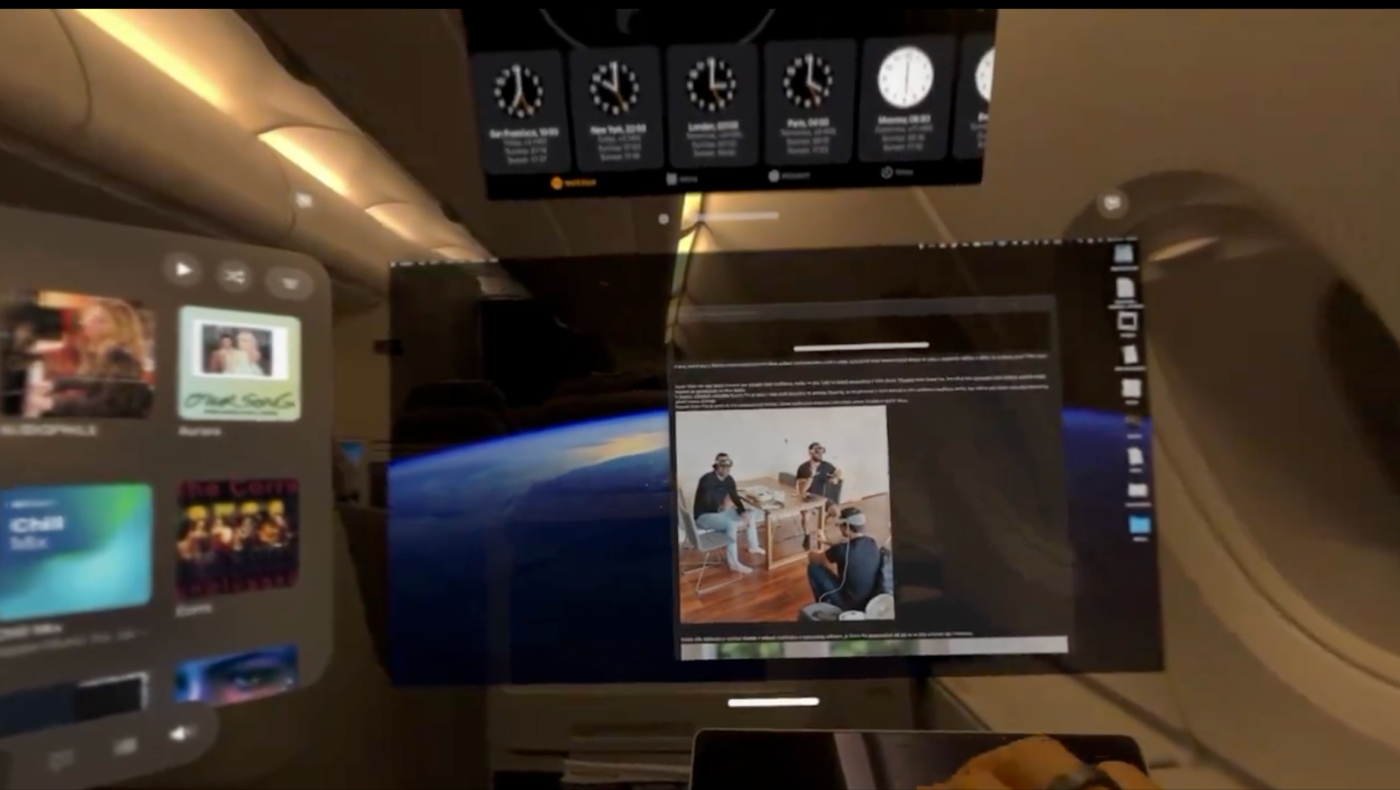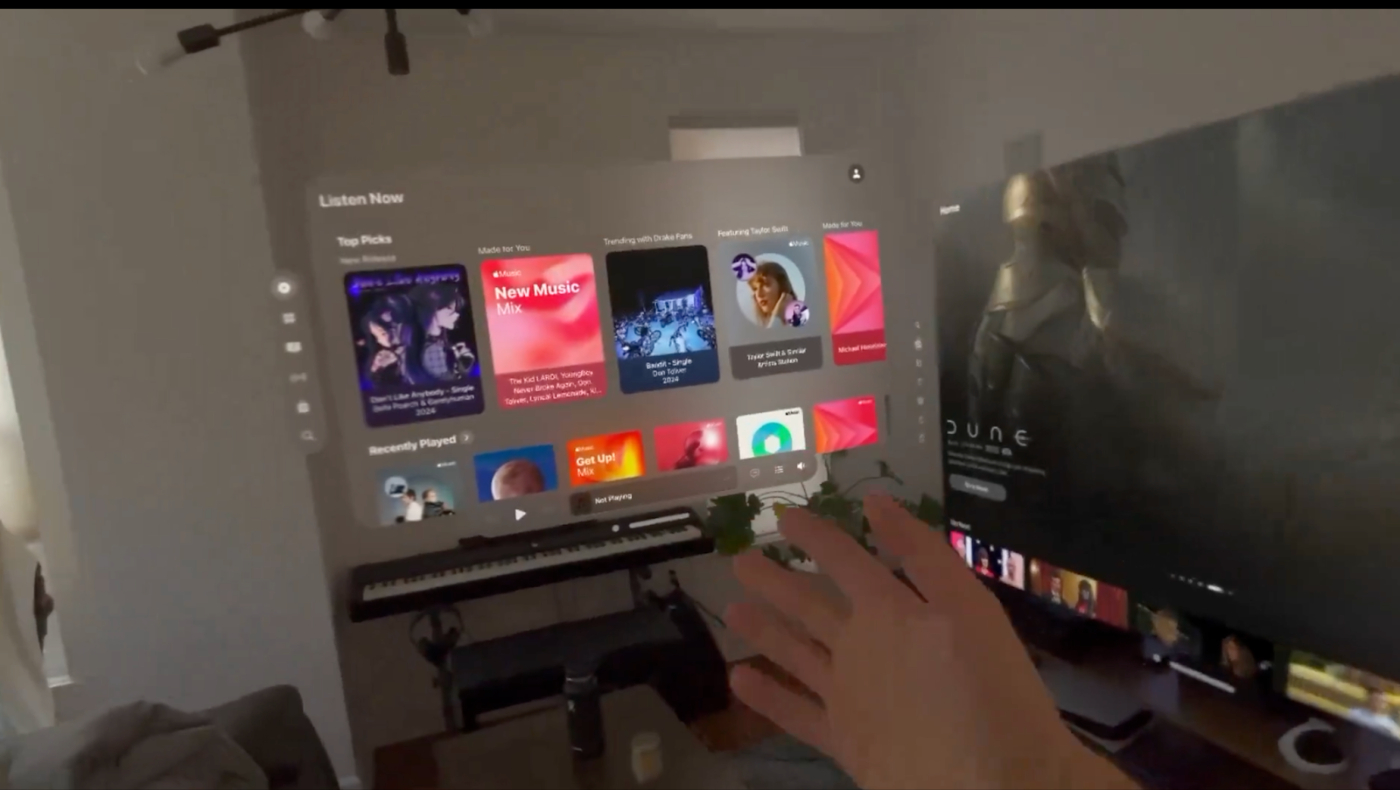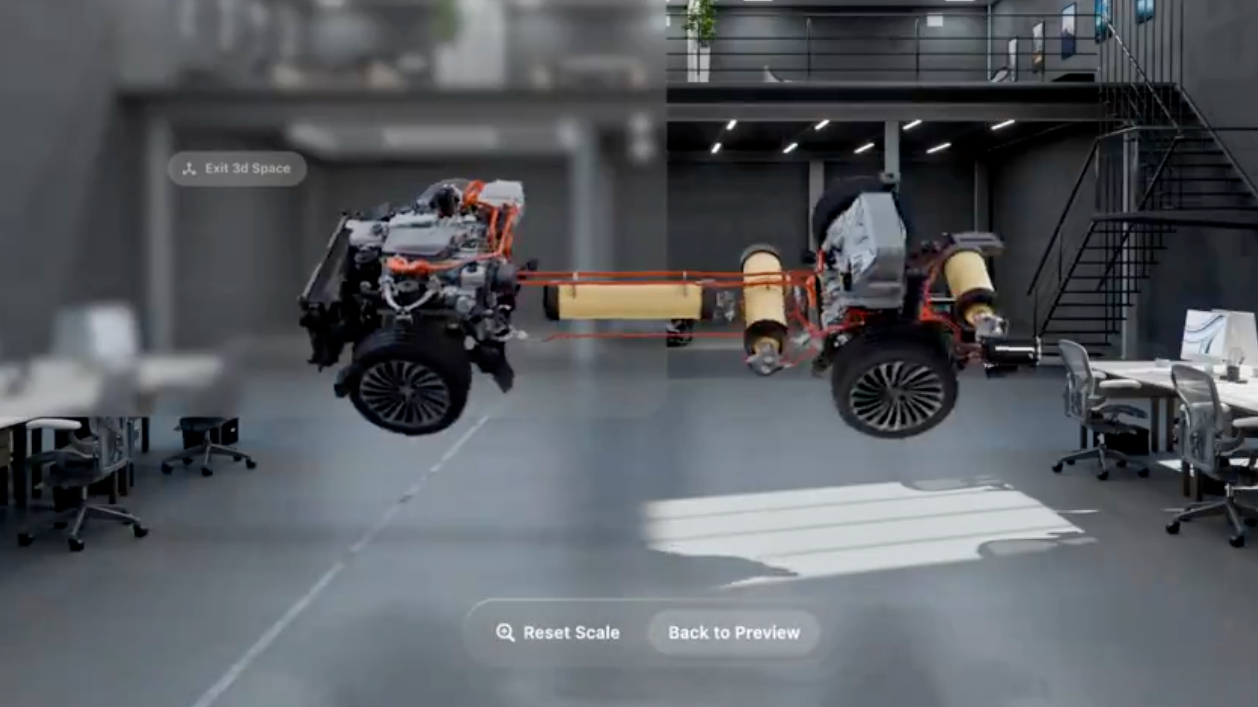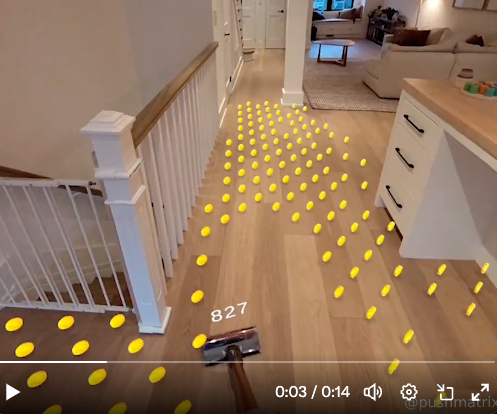
I will admit to being biased from the get-go. As I settled down into a stool at the Apple store in Chestnut Hill, Massachusetts, the occupants of the seats around me were already trying the Vision Pro, whispering “Holy shit,” and “Oh my God,” and “Is this shit real?” These folks, united in their use of profanity, were diffuse in demographic. There was an elderly grandpa grasping at invisible screens, a woman with pink hair wearing a denim jacket, a bald man who looked like he had just meandered over from a break at his IT job. All of them, no matter what they looked like, had their jaws open.
If anything, they undersold it.
The Apple Vision Pro (AVP) is the single best tech demo I’ve ever seen. I have tried an obscene number of gadgets and sat in on too many startup pitches too count. Yet nothing has come close to the Vision Pro’s first 20 minutes. During one section I watched Alicia Keys belt music in my face. There was a dinosaur and I played pinball. It was all fairly run-of-the-mill, if still spectacularly rendered, gadget demo stuff.
One moment in particular gave me a glimpse of the future. In the Photos section of the demo, there was a video of children gathered around a birthday cake to blow out the candles. Despite the Apple employee’s insistence that I move on, I replayed the video over and over again. I was there. It was the greatest home movie that humanity has ever made. It was past made present, once again. It was reality made more real.
I couldn’t help but cry. In that video, I caught a glimpse of what virtual reality could be. Devices like the AVP have the potential to be the greatest empathy generator we’ve ever dreamed up. The visual acuity has crossed the tricking-the-brain-rubicon: Some part of me was convinced that what I was viewing was real. Can you imagine what this means at scale? All of humanity can truly feel the suffering, the hope, the joy of our own past experiences, and live in the stories of others. Empathy can be a product, a gadget that people can purchase and carry with them. I think it can create a more peaceful, better world. I’m sold.
This article is not, however, a review of the headset. There are many that will help you decide whether to buy it or not. The device is not perfect: It’s heavy, the field of view is small, and it’s probably not an obvious yes for most people unless you feel the need for more screens in your life.
However, the AVP has shown enough technological ingenuity and generated enough consumer buzz that we can seriously consider the second-order questions: Who is going to make money off this thing? Which companies are going to win? How can hackers build new companies to serve this product? Should they?
These questions about virtual and augmented reality have been circulating for years. But now, with the AVP, we have enough of a foundation to start getting some answers.
A $3,500 teleportation device
You can use the Vision Pro to do three things:
- Big screen everywhere: Surf web pages anywhere, in giant dimensions, while walking around. It could be in your home, it could be on the subway. If you can do it on your phone, you can now do it on a personal IMAX screen wherever you are.
- New media formats: Watch videos that you can’t consume on a normal flat screen—i.e., three-dimensional videos. Apple calls them Immersive Videos (which are professionally made 180-degree, 8K video formats) and Spatial Videos (which are consumer-made videos that, remarkably, you can record with an iPhone 15). The Spatial Video is the demo that made me cry.
- Overlay digital assets onto the real world: In tech parlance, this is augmented reality. Because when you put the AVP on you can still view the world around you, the device can put computer graphics on top of your visual field. Think of Pokemon Go, but instead of peering through your phone screen, the AVP does it for your entire world view.
Combining these elements produces a truly novel device. However, before we merge them, let’s pick apart each of these categories so we can understand the power dynamics.
Big screen everywhere
One otherworldly review came from YouTuber Casey Neistat. Wearing the AVP, he roams around New York City, throwing up screens while at the Times Square Krispy Kreme or riding his skateboard. The most surreal moment happens as he waits for the subway, when he pulls up a movie theater-size screen playing YouTube.
Source: YouTube.
To everyone else, it looks like he’s just wearing ski goggles.
Source: YouTube.
“Standing at [a] subway stop, watching a Mr. Beast video is a pretty special experience,” Neistat says. Not to contradict him, but there is nothing special about this at all! Since it was released two weeks ago, that video of Mr. Beast comparing private islands has been watched 109 million times. Many people watched it at a subway stop—they just did so on their phones. The only thing that has shifted is that your screen is bigger, and no one else can see it.
Still, this is a dramatic improvement in entertainment. It is a miracle of technology that boggles the mind.
It is also the same old internet that can be accessed on your phone. The winners for “big screen everywhere” are the same as those of the internet. Consumer internet companies like Facebook will continue to enjoy network effects. Software companies will benefit from owning a customer’s most important data and workflows.
The “big screen everywhere” disrupts those selling monitors, TVs, and smartphone displays more than it does software companies. In all the places where small screens are inferior or more screens would be beneficial, viola—big screen delivers.
For example, you don’t have to deal with the janky 10-inch display on an airplane anymore.
Source: X.
In the living room and want to watch a movie? Behold.
Source: X.
You get the idea.
If anything, the AVP and other AR/VR devices may exaggerate the importance of software: By consolidating multiple forms of hardware into a central display device that you use for nearly everything, the software on the device becomes that much more crucial. Similar to the iPhone demolishing the camera and portable GPS businesses by putting their capabilities into a single device, so too will the AVP affect the sales of any screen you use.
The companies that were the runaway winners of the 2010s era of the internet will continue to dominate because format isn’t the central value proposition. The network of users, creators, and developers that you transport from design paradigm to design paradigm is what makes the companies dominate. YouTube is still going to be a juggernaut. Facebook is still going to keep you scrolling. There will be some design tweaks to better incorporate 3D content and more smoothly operate the hand interface, but, just like in the transition to mobile in the early 2010s, the market is the incumbents to lose.
If anything, this may actually increase the power of cloud-based software ecosystems. Because so much of the computing power on the AVP will be devoted to visual rendering, much of the computing work and data storage will have to be done on the cloud. Gaming will either be streamed or paired with local compute. Movie theaters will continue their slow rot with the AVP beating out most screens.
A large beneficiary will—unsurprisingly—be Apple itself. Many of the most magical parts of being in an Apple ecosystem, such as being able to copy on one device and paste in another, remain true on the AVP. You can extend your Macbook’s display to make it larger, enhancing productivity. You can access your iMessage account between devices. Once Apple sucks you in, they have you for life.
Analysts often break the big screen category into buckets of productivity or entertainment. That isn’t quite right. What we are really talking about is the internet. If you think having the internet on a big screen in front of you wherever you go would be cool, then that’s all that matters. Since the Apple Vision can pair with the accessories you use in your normal workflow (mouse, keyboard, etc.), it isn’t that different from your current productivity stack. It is likely less efficient than your current setup, but that’s OK. It isn’t supposed to be a total Mac replacement (yet). While there are, of course, differences and challenges today—for example the eye tracking isn’t always precise enough—it is hard to imagine a world where Apple and its developer ecosystem don’t improve this over the next five years.
New media formats
Apple’s Immersive Videos are a genuine marvel and a serious innovation in content. Other VR headsets have offered variations on the 3D entertainment format for nearly 10 years, so some critics are discounting their importance. However, when I viewed 3D content on the past generation of Meta’s VR headsets, the picture quality wasn’t good enough. You never believed you were actually there. The AVP has good enough picture quality that that is no longer the case.
Take watching sports, for example. The AVP can give you the dugout or courtside view. When someone has an amputated limb, they will experience a pain or an itch despite the limb no longer physically existing. Watching sports on the AVP was like that—in a good way. I swear I could smell the popcorn, feel the heat of the crowd around me. My body was somewhat convinced I was there. I would pay the NBA hundreds of dollars every year to watch my beloved Minnesota Timberwolves courtside. This is a brand-new chance to upsell consumers on this much more meaningful format. Three-dimensional entertainment will allow richer stories to be told.
Still, I worry this is fool’s gold for companies to dig for. Allow me to quote the great Mitch Lasky, arguably the greatest video game investor of all time:
"Content innovation grows audiences, distribution innovation grows enterprise value."
3D will allow video media companies with existing fan bases to upsell enhanced content. They can add a high value SKU to their product mix without totally reinventing the wheel. Immersive video still closely resembles a traditional TV or movie shoot—now the camera and staging are slightly different. Three-dimensional content does not, however, evolve the distribution model past the current paradigm. The apps and media will be intermediated by Apple’s App Store. YouTube and streaming services will still have a critical mass of users. The same game is being played here, just like in the big-screen-everywhere internet problem.
I imagine we will see a similar evolution to that of the creator economy. When people first started posting videos online, there was a clear divide between Hollywood-produced content and user-generated content. However, as consumer video electronics got cheaper, creators started to earn big money as YouTube videos began to outcompete professionally made content for user attention. Similarly, all immersive and 3D content will initially be made by Disney (which has already announced its partnership on this front), the NBA (a similar partnership has been announced), and other content pros. Over time, however, as iPhones get better at taking spatial video, the creator economy will intrude on this format, too. This adoption will occur faster than during the iPhone’s growth cycle, as internet penetration and monetization are further along.
In the meantime, there will be a first-mover advantage to the media format. As the powerhouse, Netflix has little need to move quickly—hence the company’s reluctance to put its app on the AVP App Store—while other media players will jump at the chance to differentiate. Expect many of them to rush out one-off specials to gauge consumer appetite. Otherwise startups will have some room to do good work on the margins in gaming and content.
There will be a use case for people to interact with 3D productivity assets. You’ll be able to meander through a three-axis chart or walk through an engineering blueprint. Box has already released a feature to do so.
Source: X.
Essentially, everyone can be Iron Man.
Source: Marvel Studios.
Overlaying digital assets onto the real world
Finally, the big unknown. Some of the most compelling proofs of concept with the AVP have been around augmenting reality with digital assets. Because the AVP does passthrough—as in, it shows you video of your surroundings—you can place unique 3D assets in combination with the room around you.
Maybe you can watch an F1 track in 3D while the main broadcast plays behind it. Or you can gamify vacuuming.
Source: X
These are demos that have been posted on X. Soon, however, they will become real products for purchase.
I’ll admit that I have the least amount of insight into this area because it’s so new. What does it mean that we can leave digital assets around the house? How does it interact with our usage of the AVP?
Of all the use cases, augmented reality is the one most bullish for startups, because so much is unknown. There are some weird, creative ideas brewing that I am not capable of thinking of. If you’re building this, email me. I would love to feature you in this newsletter.
Market questions and Evan questions
There may be some room for startups to grow in the AVP ecosystem without big companies encroaching in. Apple is only planning to produce 500,000 AVP units this year, a number small enough that most major companies won’t bother to pay attention to the device. A startup could likely achieve an early lead in any of these use cases if it is able to develop something over the next few weeks.
That timeline may be too negative—startups may have a year or two before competition heats up. Building for the AVP is a very small opportunity relative to other hardware platforms. In the U.S., the AR/VR market is only about $1 billion. In comparison, Apple has an installed base of over 2 billion active devices and an estimated 1.2 billion users. Even if the company sells out of the initial 500,000 run, only .041% of Apple users will have a device. That goal may still be too ambitious. The initial pre-order was only 180,000 units, and Apple will be hard-pressed to sell them all this year.
Frankly, I wonder why Apple isn’t playing more aggressively. The company has sunk seven years of research and development and tens of billions in budget into this project, yet has underinvested in the content and developer ecosystem. If Tim Cook truly believed this was the next platform, why isn’t he spending more? Spatial computing requires more killer apps and better content to become a major market.
Apple should’ve shown up on the doorstep of every major content producer in Hollywood with a $500 million-dollar check and free cameras to make more immersive content. The current lineup—a few immersive videos and some 3D content available on Disney+—is weak. Tim Cook only met with NBA officials to demo the league’s app on the device’s launch day. Why didn’t this happen months ago? Why weren't there immersive video formats available at launch? Where is the NFL or Premier League?
I have even more questions. On February 5, after the AVP had already been live for four days, Apple launched the trailer for its 2024 slate of shows on Apple TV+. Not once did the lineup mention immersive video or other 3D formats. The company spends $7 billion a year on content for Apple TV+ and couldn’t earmark any of that to make its launch more valuable?
With an average sale price of $3,750, a sold-out year for the AVP would come to about $1.9 billion in hardware sales alone. This is a company that had nearly $100 billion in cash flow just last year. It can and should be investing significantly more in its ecosystem.
To be fair, Apple TV is directly or adjacently competitive with many content companies, so Apple may have some hesitation about subsidizing competitors. Yet the spatial computing opportunity is so much larger than any streaming service revenue line. If the AVP can live up to its full potential. Apple has a product that can steal market share from laptops, desktops, televisions, and movie theaters. It will pull users ever deeper into the Apple ecosystem, enhancing the value of Airpods, iPhones, and Macs. If the company can pull it off, this is a trillion-dollar opportunity.
The last time I was this excited about a product was when GPT-4 launched. That both AI and the Vision Pro are happening simultaneously should be a clarion call to builders. We’re on the cusp of multiple platform shifts, so be ready.
Editor’s note: One of the promises we make to readers is that we’ll tell you about the future first. With the Vision Pro, we’ve aimed to give you in-depth and advanced analysis: from Evan’s initial excitement when it was first announced, to explaining the engineering challenges that Apple had to conquer, to how Apple built its design language into the AVP, and even to how the metaverse could replace PCs. Become a paid subscriber to get our latest insights in your inbox.
The Only Subscription
You Need to
Stay at the
Edge of AI
The essential toolkit for those shaping the future
"This might be the best value you
can get from an AI subscription."
- Jay S.
Join 100,000+ leaders, builders, and innovators

Email address
Already have an account? Sign in
What is included in a subscription?
Daily insights from AI pioneers + early access to powerful AI tools

















Comments
Don't have an account? Sign up!
The price tag is another barrier to entry. With the Meta Quest being on par with a gaming system, people will be ok with the lower quality. It get's better with each release. I appreciate seeing where the future is headed, but at the cost of a used car, most people aren't going to think twice about getting an AVP.
@every.eb6c40 I don't think so—the sales numbers are so abysmal in its the Quest's current format that I think they have no choice but to go upmarket.
@ItsUrBoyEvan It makes sense for them to go up market. I can't imagine Apple ever selling anything that isn't "premium" and I also can't imagine them selling anything at a loss (or break even) for the sake of market share. That just ins't their MO.
I think the product looks great and it's definitely the best you can get right now. The specs will eventually trickle down to other product price points as the pieces get cheaper and volume of sells increase. This is a great example of what the future holds for this product category, though. I'm really looking forward to the next few years as I think AR and VR will be a game changer.
Loved reading your write up. Thank you. This part was pretty moving for me. "Can you imagine what this means at scale? All of humanity can truly feel the suffering, the hope, the joy of our own past experiences, and live in the stories of others. Empathy can be a product, a gadget that people can purchase and carry with them. I think it can create a more peaceful, better world. I’m sold." Thank you
Great insights. Initial distribution and price point make sense. A bit of a head-scratcher with limited content via partnerships and developer programs. However, being mindful about a product this revolutionary makes sense if we consider the ripple effects of AI (e.g. deep fakes, fraud) and social media (e.g. mental health, false news). Being a trailblazer is great as long as society doesn't get torched in the process.